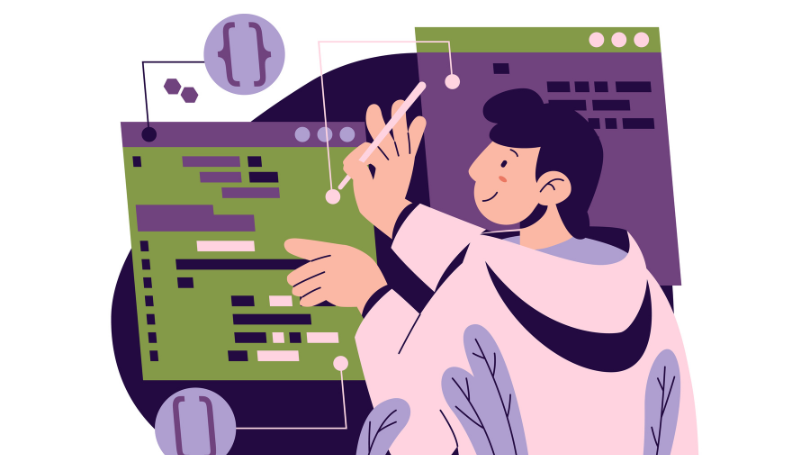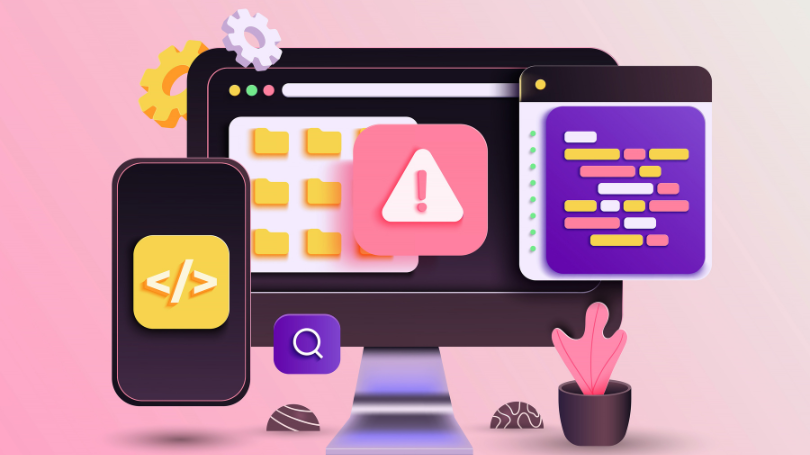Home / Functional Web Design / Web Design / The Rise of Dark Mode: How It Affects Web Design and Digital Marketing
Key Takeaways
- Dark mode is growing in popularity due to its benefits for eye strain, focus, and aesthetics.
- Websites need to adapt to this trend by carefully considering color palettes, typography, and imagery for optimal readability and accessibility in dark mode.
- Dark mode can enhance brand image, improve user engagement, and indirectly support SEO efforts.
- Implementing dark mode requires thoughtful design, user controls, and thorough testing across different devices and browsers.
- Mobile-first design is crucial for dark mode, ensuring a seamless and optimized experience on smaller screens with touch optimization and performance considerations.
Have you ever had tired eyes after using your computer at night? That’s probably from the bright screen. Now, there’s dark mode, a smooth, comfortable alternative. That’s better for your eyes, and it’s really common now! Phones, laptops, apps, and dark mode websites are all making the switch.
Dark mode design is becoming increasingly popular and is changing how we design websites. Designers now need to consider how their website looks and works in dark mode. This means choosing the right colors, fonts, and images to ensure a great dark mode UX (user experience) for their visitors.
Why is dark mode so important? It offers many benefits. It can reduce eye strain, improve accessibility, and even make your website look more modern. Plus, people simply prefer dark mode websites these days!
This guide explores the rise of dark mode and its impact on dark mode web design. We’ll discuss how to create a website that looks amazing and functions perfectly in dark mode, and we’ll also cover the benefits for your users and your business.
Why Are We All Going Dark Mode?
Dark mode’s popularity has exploded for a reason. It offers a welcome pause from the constant glare of bright interfaces, reducing eye strain and improving visual comfort. This shift towards darker hues is a response to the growing need for digital well-being and a better online experience. Let’s explore the reasons behind this digital shift and why dark mode is becoming the preferred choice for many users.

It’s Easier on the Eyes
Staring at a bright screen all day can cause eye strain, headaches, and even disrupt your sleep. Dark mode websites reduce the amount of blue light emitted from your screen, making them easier on your eyes, especially in low-light conditions. This is a major reason why many people are switching to dark mode, particularly those who spend long hours in front of computers.
Improved Focus and Concentration
Many users find that dark mode helps them focus better by reducing visual disorder and minimizing distractions. The darker background allows content to stand out more, making it easier to concentrate on what you’re reading or watching. This significantly impacts dark mode UX, as users can engage with content more effectively.
Aesthetics and Modernity
Let’s face it, dark mode just looks cool. It has a sleek, modern aesthetic that many people find more visually appealing than the traditional bright white interface. This is particularly true for younger generations, who are drawn to the stylish and sophisticated look of dark mode websites.
Accessibility for Everyone
Dark mode plays an important role in making websites more accessible. Dark mode can significantly improve readability and reduce eye strain for people with visual impairments or light sensitivity. Offering a dark mode option on your website can ensure dark mode accessibility and make your content more inclusive and user-friendly for everyone.
Saving Battery Life (Sometimes)
While the evidence is mixed, some studies suggest that dark mode can help conserve battery life on devices with OLED or AMOLED displays. These displays emit light directly from each pixel, so when the pixel is black, it’s essentially turned off, saving energy. This can be a compelling benefit of dark mode for users who are always on the go.
The Influence of Tech Giants
The adoption of dark mode by major tech companies like Apple, Google, and Microsoft has undoubtedly played a significant role in its widespread popularity. When these giants introduce dark mode options in their operating systems and apps, they normalize the concept and encourage users to embrace it across all their devices and dark mode websites.
How Dark Mode Impacts Web Design
Dark mode presents a new set of challenges and opportunities for web designers. It’s not simply a matter of inverting colors; it requires a thoughtful approach to dark mode web design to ensure readability, accessibility, and a positive user experience.

How Dark Mode Is Changing The Face Of Web Design
Color Palette and Contrast
In dark mode design, color takes on a new dimension. The traditional bright backgrounds are replaced with darker hues, requiring a great selection of foreground colors to ensure sufficient contrast and readability on your dark mode website.
- Embrace Darker Hues – Instead of pure black, consider using dark grays or deep blues as the background color for your dark mode website. This can create a softer, more visually appealing aesthetic.
- Strategic Color Choices – Choose accent colors that pop against the dark background, but avoid overly bright or neon colors that can cause eye strain.
- Accessibility First – Ensure that your color choices meet accessibility standards, particularly for users with visual impairments. Use online contrast checkers to verify that your text and UI elements have sufficient contrast against the background to ensure dark mode accessibility.
Typography and Legibility
Font choice is important in dark mode web design. Fonts that look great on a white background may not be as legible on a dark background.
- Font Weight and Style – Use slightly bolder font weights to improve readability in dark mode. Avoid overly thin or delicate fonts that can get lost against the dark background.
- Font Size – Consider increasing the font size slightly to enhance legibility, especially for body text on your dark mode website.
- Line Height and Spacing – Adjust line height and letter spacing to prevent text from appearing cramped or overwhelming in dark mode.
Imagery and Graphics
Images and graphics need to be optimized for dark mode to prevent them from looking overexposed or out of place on your dark mode website.
- Transparency and Overlays – Use transparent PNGs or SVGs for logos and icons to allow them to blend easily with the dark background.
- Image Adjustments – Adjust the brightness and contrast of images to ensure they are visible and don’t clash with the dark mode aesthetic.
- Alternative Images – In some cases, you may need to create alternative versions of images specifically for dark mode to ensure optimal visual appeal on your dark mode website.
User Interface (UI) Elements
Buttons, forms, and other UI elements must be designed with dark mode in mind to maintain a consistent and user-friendly experience, contributing to a positive dark mode UX.
- Clear Visual Hierarchy – Use visual elements like shadows, borders, and subtle gradients to create a clear visual hierarchy and guide users through the interface.
- Button Contrast – Ensure that buttons have sufficient contrast against the background and are clearly distinguishable as interactive elements in dark mode.
- Form Fields – Use light backgrounds for form fields to ensure text is easily readable in dark mode.
The Benefits of Dark Mode for Digital Marketing
Dark mode is important in digital marketing, not just a design preference. It presents a unique opportunity to enhance your brand, improve user engagement, and even boost your SEO efforts. By embracing the dark side and incorporating the benefits of dark mode web design, businesses can create a more impactful and user-centric online experience.

How Dark Mode Helps Your Digital Marketing Strategy
Branding and Aesthetics
Dark mode offers a unique opportunity to boost your brand’s visual identity and create a distinctive dark mode website.
- Sophistication and Modernity – Dark mode is often associated with sophistication, elegance, and a cutting-edge aesthetic. By incorporating dark mode into your website and marketing materials, you can create a modern and visually striking brand image.
- Enhanced Visual Hierarchy – Dark mode design can help emphasize key elements and create a clear visual hierarchy, drawing attention to your call-to-actions and important information.
- Emotional Connection – The darker color palette can evoke a sense of calm, focus, and even mystery, allowing you to create a unique emotional connection with your audience through your dark mode website.
User Engagement and Conversion
Dark mode can positively impact user engagement and conversion rates, contributing to a better dark mode UX.
- Reduced Eye Strain – By minimizing eye strain, dark mode can encourage users to spend more time on your dark mode website and engage with your content.
- Improved Focus – Dark mode’s reduced visual disorder can help users focus on your key messages and calls to action, potentially leading to higher conversion rates.
- Mobile-First Approach – With the majority of internet traffic now coming from mobile devices, dark mode is essential for providing a comfortable and engaging experience for users on the go.
SEO Implications
While dark mode doesn’t directly impact SEO rankings, it can indirectly influence your website’s search results performance.
- Improved User Experience – A positive user experience is a key factor in SEO. By providing a user-friendly and accessible dark mode experience, you can improve user engagement, reduce bounce rates, and ultimately boost your dark mode website’s SEO performance.
- Mobile Optimization – Google prioritizes mobile-friendly websites in its search results. Dark mode is essential for optimizing your website for mobile users, as it improves readability and reduces battery consumption on mobile devices.
Creating An Outstanding Online Visibility
With many websites using bright designs, dark mode offers a unique and stylish alternative. It offers a unique and memorable visual experience that can capture attention and leave a lasting impression on your audience.
Implementation of Dark Mode on Your Website
Implementing dark mode on your website might seem intimidating, but it’s more achievable than you think. With the right approach and a focus on user experience, you can seamlessly integrate dark mode into your web design. This section provides a step-by-step guide to help you navigate the process and create a website that shines in the dark.

Step-By-Step Guide On Implementation Of Dark Mode On Your Website
Choose Your Implementation Method
There are several ways to implement dark mode on your website:
- CSS – This is the most common and recommended method. CSS media queries can detect the user’s preferred color scheme and apply different styles accordingly.
- JavaScript – JavaScript can be used to strongly switch between light and dark modes based on user interaction or system settings.
- Plugins and Libraries – Several plugins and libraries are available to simplify the implementation process, especially for content management systems like WordPress.
Design with Accessibility in Mind
Accessibility should be a top priority when implementing dark mode.
- Sufficient Contrast – To meet accessibility standards, ensure that your text and UI elements have sufficient contrast against the background.
- Color Blindness – Consider users with different types of color blindness and choose a color palette that is distinguishable for everyone.
- Keyboard Navigation – Make sure your website is fully navigable using the keyboard for users who cannot use a mouse.
Provide User Control
Give users the freedom to choose their preferred mode.
- Toggle Switch – Include a clear and easily accessible toggle switch that allows users to switch between light and dark modes at any time.
- Respect User Preferences – Use cookies or local storage to remember user preferences so they don’t have to switch modes every time they visit your website.
Test Thoroughly
Testing is important to ensure an ideal dark mode experience across all devices and browsers.
- Cross-Browser Compatibility – Test your dark mode implementation on different browsers (Chrome, Firefox, Safari, Edge) to ensure consistent appearance and functionality.
- Device Testing – Test on various devices (desktops, laptops, tablets, smartphones) to ensure responsiveness and excellent viewing experience.
- A/B Testing – Consider conducting A/B testing to compare the performance of your light and dark modes and identify any areas for improvement.
Consider Specific Website Needs
Different types of websites may require specific considerations for dark mode implementation.
- E-commerce Websites: – Pay close attention to product images and ensure they are displayed correctly in dark mode.
- Content-Heavy Websites – Focus on readability and ensure that long-form content is easy to consume in dark mode.
- Portfolio Websites – Ensure that your creative work is showcased effectively in dark mode, with appropriate contrast and visual appeal.
Essential Design Considerations for Your Dark Mode on Mobile
You’ve probably seen dark mode on websites, but it’s also making its way into mobile apps too. Users are increasingly demanding apps that offer a dark mode option, and for good reason. Dark mode enhances the mobile experience by reducing eye strain, improving readability in low-light conditions, and even extending battery life. This directly impacts how we approach dark mode web design, as users expect a consistent experience across all platforms.

Designing for dark mode on mobile requires careful consideration of several factors to ensure a smooth and enjoyable user experience on your dark mode website.
Key Principles To Consider For Dark Mode Design
Mobile-First Approach
Prioritize a mobile-first approach to dark mode design, ensuring your app looks and functions smoothly in dark mode on all devices. This means considering screen sizes, resolutions, and aspect ratios to create a responsive and optimized experience for your dark mode website.
Built-in Navigation
Design built-in navigation flows that are easy to use in dark mode, ensuring an easy user experience. Clear visual cues and well-defined interactive elements are crucial for guiding users through your app, especially in dark mode.
Enhanced Readability
Carefully select color palettes and typography to optimize readability and minimize eye strain in dark mode. Sufficient contrast between text and background is essential, as is choosing fonts that are legible in low-light conditions. This is particularly important for dark mode websites viewed on mobile devices.
Touch Optimization
Design touch targets that are easily accessible and responsive in dark mode, ensuring a smooth and maximum user experience. Adequate spacing between interactive elements prevents accidental touches and frustration, especially when using dark mode on smaller screens.
Performance Optimization
Understand the impact of dark mode on app performance, particularly on OLED screens. Optimize your app for better efficiency and responsiveness by minimizing resource use and ensuring smooth transitions between light and dark mode. This can also influence the performance of your dark mode website on mobile devices.
Sticking to these principles can help you create mobile apps that effectively embrace the dark mode, providing users with a comfortable, engaging, and visually appealing experience that complements your dark mode website.
Implement Dark Mode in Web Design and Digital Marketing
The dark mode is changing how we experience technology, from visual preferences to digital interactions. This shift towards darker interfaces, evident in the growing popularity of dark mode websites, signifies a broader movement toward user-centric design, prioritizing accessibility, visual comfort, and personalized experiences.

While initially driven by individual preferences and a desire for reduced eye strain, dark mode has evolved into a powerful tool for enhancing user engagement, improving focus, and creating a more inclusive online environment. It’s proof of the growing awareness of digital well-being and the importance of designing with the user in mind, especially when it comes to dark mode web design.
Dark mode is assured to become an essential part of the digital experience. Websites and applications that fail to embrace this trend neglecting the principles of dark mode design, risk alienating users and falling behind the curve. By incorporating dark mode effectively, businesses can demonstrate their commitment to user satisfaction, and accessibility, and create a more enjoyable online experience for everyone. This is particularly important for those who spend hours interacting with dark mode websites.
Partnering with Experts on Creating Engaging and Accessible Digital Websites Using Dark Mode
Bless Web Designs specializes in crafting engaging and accessible websites with a keen focus on utilizing the ability to use dark mode. Our team of expert designers stays forward with the competition, incorporating the latest trends and technologies to create websites that not only look stunning but also provide a seamless and enjoyable user experience. We recognize the growing importance of dark mode in enhancing readability, reducing eye strain, and catering to user preferences.
Partnering with Bless Web Designs means collaborating with a team that prioritizes accessibility and inclusivity. We meticulously design each website to ensure it is easily navigable and enjoyable for all users, including those with visual impairments. By combining our expertise in dark mode design with a commitment to accessibility, we empower businesses to create a positive and impactful online presence that resonates with a wider audience.
Ready to enhance user experience and boost engagement? Contact Bless Web Designs or schedule a free consultation for a dark mode website that provides a seamless and enjoyable user experience.


